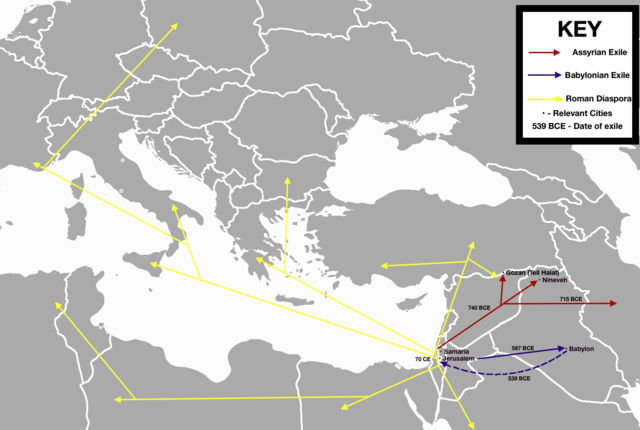
Routes of Jewish expulsion and deportation | (c) en.wikipedia.org/wiki/Jewish_diaspora
Our exploration of the ancient Jewish diaspora finds Mesopotamia to be an incredibly complicated subject. It was shaped by forced relocations, theological challenges, and a rich daily life. The diaspora in Egypt was different. Mesopotamia, especially Babylonia, became pivotal. This was due to invasions by the Assyrians and Babylonians in the 8th and 6th centuries BCE.
Learn More About Our Shared Jewish Heritage on a Glatt Kosher Holiday
Embarking on a journey into our shared Jewish heritage is like unraveling our rich past. It sheds light on our shared story. Join us on a special glatt kosher cruise. It will be immersive and enriching. We warmly invite you to come. This unique adventure blends the joy of exploration with the luxury of kosher accommodations. It’s more than just a vacation; it’s a cultural odyssey. It fosters connections and deepens our understanding of our shared history. Explore the world while savoring the comfort of a kosher holiday – join us on one of our Jewish trips and let the journey unfold.
The Galut: A Divine Challenge
Jeremiah spoke the words during the 6th-century exile to Babylonia. They give insight into the essence of Jewish life in diaspora. “Build ye houses and dwell in them,” he declared, emphasizing that the exile was a divine ordination. This notion is of galut, or diaspora. It mandated Jews to commit to their new lands. They must pray for their prosperity and join in the growth of their adopted cities.
Yet, the theological challenge loomed large. For a people accustomed to associating G-d with a specific place, the foreign landscapes of Babylonia raised questions of abandonment. Jeremiah’s reassurance became a beacon. It echoed through generations, offering comfort in spiritual upheaval.
The Murasu Archive: Unveiling Daily Life
The Murasu Archive is a collection of 5th-century clay tablets from the Bene Murasu, a banking family. It offers a fascinating glimpse into the lives of Jews in ancient Babylonia. About 8% of the names in this archive are Jewish. They are identified by theophoric elements that invoke the name of the Jewish G-d.
What’s striking is a transformation around 480 BCE. A Tshuva movement unfolded, leading to a surge in theophoric names, indicating a reconnection with religious identity. This name change shows that Babylonian Jews tried hard. They did this to keep and strengthen their culture and religion.
Occupations and Social Dynamics
The Murasu Archive sheds light on the diverse occupations of Babylonian Jews. The community did everything from military service and animal care to real estate dealings and government roles. They had a wide range of activities. This challenges stereotypes. It shows a complex society that included some enslaved Jews.
The community was not all rich. The archive suggests a diverse socio-economic reality. It had a big middle and lower class among Babylonian Jews.
The Exilarch and Cultural Impact
In politics, Babylonian Jewry had a complex organization. It had the exilarch as the head of the exile. The Parthian Empire recognized this figure. He played a key role in the politics and culture, but not without tensions. This was especially true as Jewish academies rose in the third century.
The Nehutei symbolized the growth of communities and cultural exchange between Babylon and Jerusalem. They showed the dynamic relationship between these centers. The adoption of Aramaic as the literary lingua franca further cemented Babylon’s status as a significant hub of Jewish culture.
Unraveling Stories: Anileus and Asineus
Not all narratives of Jewish life in Babylonia are harmonious. Josephus recounts the tale of two brothers, Anileus and Asineus. They carved an independent path and created a brief state. It challenged the Parthian Empire. This episode adds a layer. It is fascinating. It adds to the complex politics among the Jews in Mesopotamia.
As we delve into the history of the Jewish diaspora in Mesopotamia, we encounter a vibrant community. They faced exile’s challenges. They remade their identity and added to ancient Mesopotamian society’s diversity. This chapter is on Jewish history. It lays the foundation for the culture that defined Babylonian Jewry.
Embark on an Unforgettable Kosher Holiday Adventure with Kosher River Cruises
Exploring our shared Jewish heritage is a journey of discovery, and we invite you to join us on a riverboat cruise that transcends the ordinary. Kosher River Cruises offers a unique experience. You can deepen your understanding of our shared history. Immerse yourself in luxury. Relish fine kosher dining. And take part in daily services that lift your spiritual journey. This isn’t just a vacation; it’s a Jewish trip that combines cultural exploration with the comfort of upscale travel. Discover fabulous destinations while creating lasting memories on this exceptional Kosher holiday adventure.
